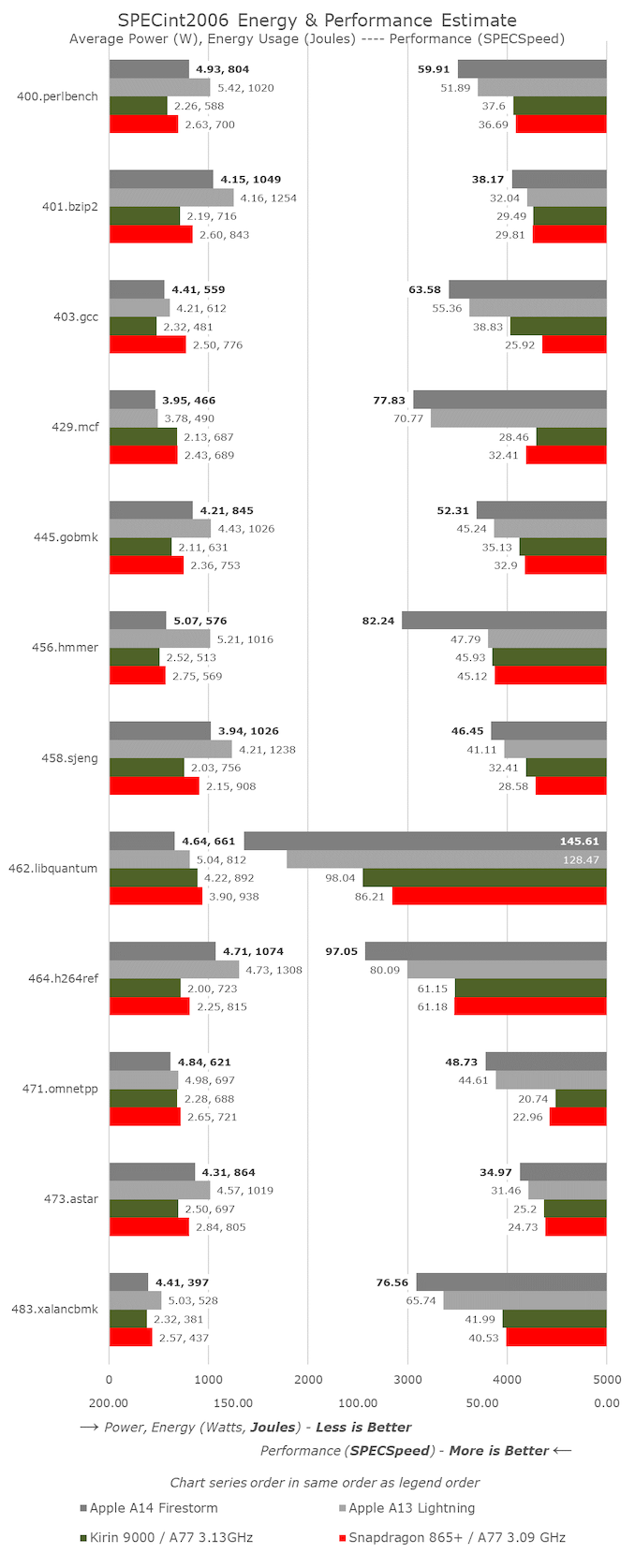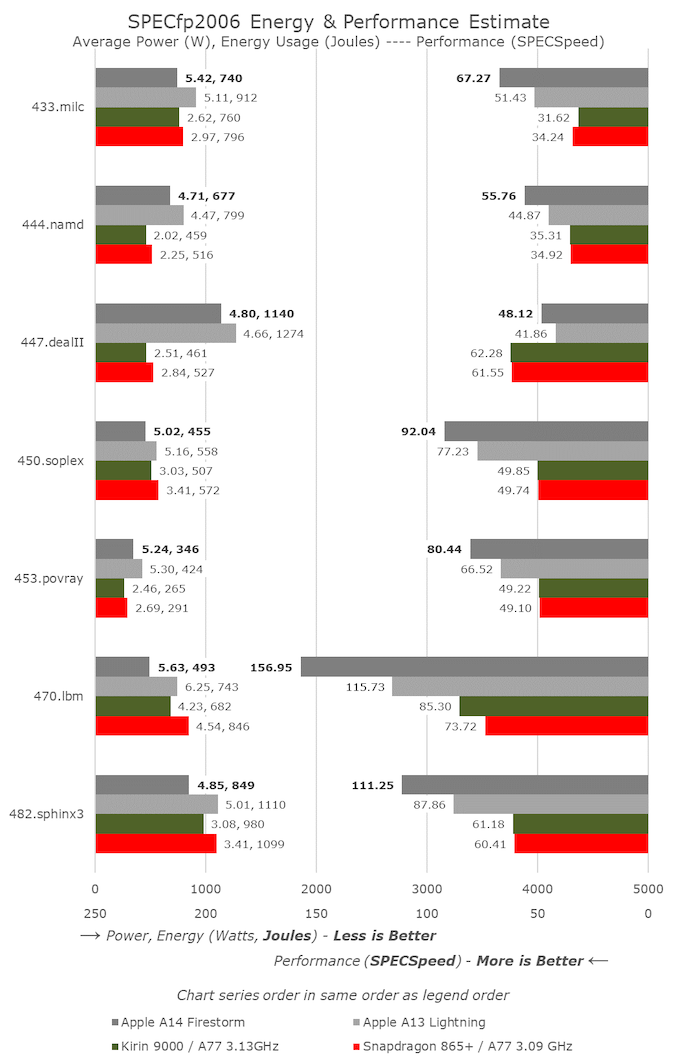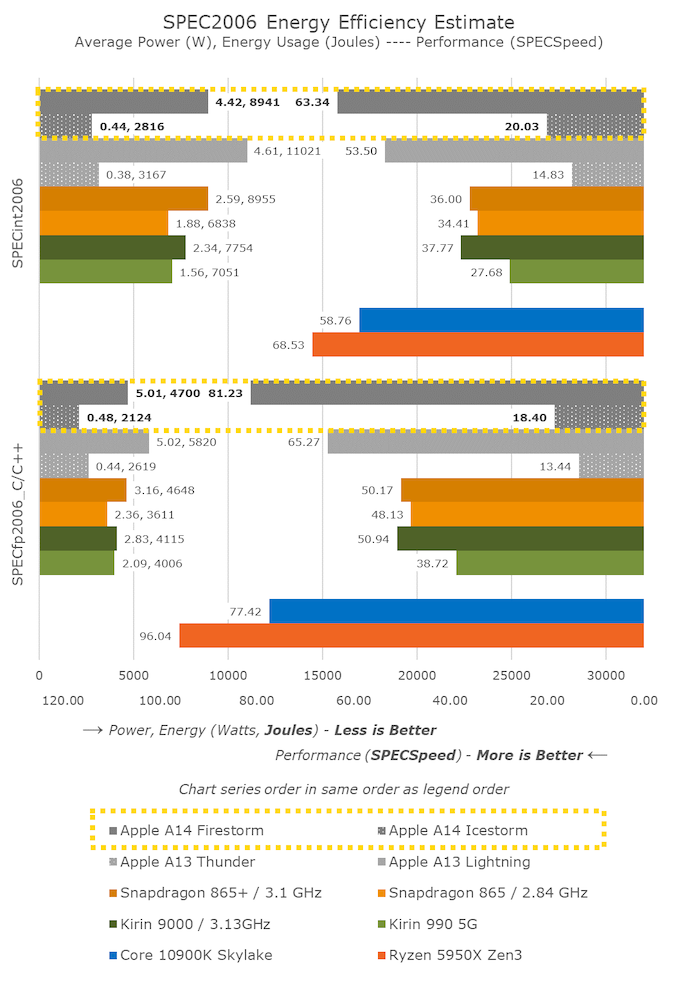Apple Announces The Apple Silicon M1: Ditching x86 - What to Expect, Based on A14
by Andrei Frumusanu on November 10, 2020 3:00 PM EST- Posted in
- Apple
- Apple A14
- Apple Silicon
- Apple M1
Dominating Mobile Performance
Before we dig deeper into the x86 vs Apple Silicon debate, it would be useful to look into more detail how the A14 Firestorm cores have improved upon the A13 Lightning cores, as well as detail the power and power efficiency improvements of the new chip’s 5nm process node.
The process node is actually quite the wildcard in the comparisons here as the A14 is the first 5nm chipset on the market, closely followed by Huawei’s Kirin 9000 in the Mate 40 series. We happen to have both devices and chips in house for testing, and contrasting the Kirin 9000 (Cortex-A77 3.13GHz on N5) vs the Snapdragon 865+ (Cortex-A77 3.09GHz on N7P) we can somewhat deduct how much of an impact the process node has in terms of power and efficiency, translating those improvements to the A13 vs A14 comparison.
Starting off with SPECint2006, we don’t see anything very unusual about the A14 scores, save the great improvement in 456.hmmer. Actually, this wasn’t due to a microarchitectural jump, but rather due to new optimisations on the part of the new LLVM version in Xcode 12. It seems here that the compiler has employed a similar loop optimisation as found on GCC8 onwards. The A13 score actually had improved from 47.79 to 64.87, but I hadn’t run new numbers on the whole suite yet.
For the rest of the workloads, the A14 generally looks like a relatively linear progression from the A13 in terms of progression, accounting for the clock frequency increase from 2.66GHz to 3GHz. The overall IPC gains for the suite look to be around 5% which is a bit less than Apple’s prior generations, though with a larger than usual clock speed increase.
Power consumption for the new chip is actually in line, and sometimes even better than the A13, which means that workload energy efficiency this generation has seen a noticeable improvement even at the peak performance point.
Performance against the contemporary Android and Cortex-core powered SoCs looks to be quite lopsided in favour of Apple. The one thing that stands out the most are the memory-intensive, sparse memory characterised workloads such as 429.mcf and 471.omnetpp where the Apple design features well over twice the performance, even though all the chip is running similar mobile-grade LPDDR4X/LPDDR5 memory. In our microarchitectural investigations we’ve seen signs of “memory magic” on Apple’s designs, where we might believe they’re using some sort of pointer-chase prefetching mechanism.
In SPECfp, the increases of the A14 over the A13 are a little higher than the linear clock frequency increase, as we’re measuring an overall 10-11% IPC uplift here. This isn’t too surprising given the additional fourth FP/SIMD pipeline of the design, whereas the integer side of the core has remained relatively unchanged compared to the A13.
In the overall mobile comparison, we can see that the new A14 has made robust progress in terms of increasing performance over the A13. Compared to the competition, Apple is well ahead of the pack – we’ll have to wait for next year’s Cortex-X1 devices to see the gap narrow again.
What’s also very important to note here is that Apple has achieved this all whilst remaining flat, or even lowering the power consumption of the new chip, notably reducing energy consumption for the same workloads.
Looking at the Kirin 9000 vs the Snapdragon 865+, we’re seeing a 10% reduction in power at relatively similar performance. Both chips use the same CPU IP, only differing in their process node and implementations. It seems Apple’s A14 here has been able to achieve better figures than just the process node improvement, which is expected given that it’s a new microarchitecture design as well.
One further note is the data of the A14’s small efficiency cores. This generation we saw a large microarchitectural boost on the part of these new cores which are now seeing 35% better performance versus last year’s A13 efficiency cores – all while further reducing energy consumption. I don’t know how the small cores will come into play on Apple’s “Apple Silicon” Mac designs, but they’re certainly still very performant and extremely efficient compared to other current contemporary Arm designs.
Lastly, there’s the x86 vs Apple performance comparison. Usually for iPhone reviews I comment on this in this section of the article, but given today’s context and the goals Apple has made for Apple Silicon, let’s investigate that into a whole dedicated section…













644 Comments
View All Comments
daveedvdv - Thursday, November 12, 2020 - link
Fun fact: One of the ways Rosetta 2 is faster than the original Rosetta (which was no slouch) is that Rosetta 2 doesn't have to do endianness transcription.dotjaz - Wednesday, November 11, 2020 - link
Several? More like one. X1 is quite close to Lightning (int) and Firestorm (fp).bobdesnos - Tuesday, November 10, 2020 - link
need 4 ys after we will seeLuminar - Wednesday, November 11, 2020 - link
X1 is probably dead in the waterSpunjji - Thursday, November 12, 2020 - link
Not really - it won't have to compete with Apple's CPU in any market besides phones, and TBH Android and iOS aren't really "competitors" in that sense.misan - Wednesday, November 11, 2020 - link
I think you are missing the point where Zen3 is consuming 4 times the power to get comparable performance. These tests re comparing a sub 5 watt phone CPU to latest and greatest of x86 desktop CPUs. I believe the ridiculousness of this situation has not properly sank in yet.vais - Wednesday, November 11, 2020 - link
I don't understand what exactly those benchmarks are testing. Even it apple's architecture is 3-4 times more efficient, such close scores are unexpected between a 5watt vs 110 watt CPUs.To me it seems this benchmark doesn't accurately represent the real world performance of the different CPUs.
Coldfriction - Wednesday, November 11, 2020 - link
My opinion is that using dedicated silicon for a specific task and not generic CPU computing is where almost ALL of the improved performance comes from. Apple is including a lot of dedicated silicon that isn't just general computing. A Zen 3 Ryzen has some of that, but most of it is general computing. Programmable silicon will never be as fast as dedicated silicon. The M1 will look great for very specific things, and admittedly they'll be the very specific things that Apple users use the most, so it's likely a win for them. The technological claims however are bogus. Like you said, there's essentially no way that Apple made a general computing CPU that is faster than Intel or AMD; it's all the dedicated silicon.michael2k - Wednesday, November 11, 2020 - link
Like you said, there's essentially no way that Apple made a general computing CPU that is faster than Intel or AMD; it's all the dedicated silicon.It’s like you didn’t read this article or any other Anandtech article on Apple’ A series CPUs. It’s got an 8 wide cpu design; wider than Intel or AMD, it’s got 12MB L2 cache, and a much larger reorder buffer. It’s also got 8 cores, larger than Intel’s default 4 or 6, even if half of them are the efficiency cores.
Coldfriction - Wednesday, November 11, 2020 - link
No doubt what they have is efficient. But their claims are out of this world high. If it was simply a matter of making a wider CPU design, AMD or Intel would have done exactly that years ago. If it were simply a matter of making a larger L2 cache, AMD or Intel would have done that years ago.The claims are extraordinary, very extraordinary. Extraordinary claims need extraordinary evidence. Apple didn't provide that. We have yet to see any real details and this article is very very specific using a very small scale test.
CPU design is somewhat of a solved art these days. When you normalize things a specific way, it looks like things are better than they are in absolute terms. I've no doubt Apple has the best performing CPU cores for the power, but that isn't in absolute terms.
What this article needs to emphasize is that custom built silicon ALWAYS punches above its weight and performs better than generic computing devices EVER will. I watched the M1 presentation. The games looked anemic and low FPS. That's not 3X more powerful or whatever they were claiming. I want absolute performance, not normalized against specific metric performance. I also want full compatibility and not a locked ecosystem. I'll never buy a locked down Apple product like this because of the cage it would put me in.